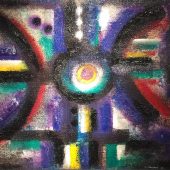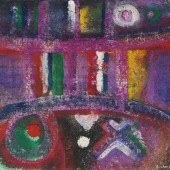Ahmed Cherkaoui
A prominent modernist artist in North Africa, Ahmed Cherkaoui drew on a spectrum of signs and shapes derived from the folk art and national heritage of Morocco. The calligraphy he learned at Quranic school and his mother’s traditional Amazigh tattoos that he encountered at a young age both formed part of his visual language, while later he was influenced by artists including Roger Bissière and Paul Klee, and the Art Informel movement. After studying graphics at the École des Metiers d’Art de Paris from 1956 to 1959, Cherkaoui spent a year at Warsaw’s Academy of Fine Arts in 1961 and held his first solo show in Paris at the Atelier de Lucienne Thalheimer. Using a range of materials that included surfaces such as burlap, Cherkaoui’s attention to tactility, colour, line and shape hint at the essential elements of different sign systems. Numerous retrospective exhibitions have been organised, including at the Institut du Monde Arabe in Paris in 1996 and regularly at the Salon de Mai in Paris.
استهوت أحمد الشرقاوي، فنان الحداثة البارز في شمال إفريقية، سلسلة من الرموز والأشكال المستوحاة من الفن الشعبي والتراث الوطني المغربي. وشكل الخط العربي الذي تعلمه في مدرسة القرآن، ووشوم والدته الأمازيغية التقليدية التي كان يراها منذ الصغر، جزءاً من لغته البصرية، بينما تأثر لاحقاً بفنانين آخرين، من بينهم روجي بيسيير وبول كلي، وحركة "اللاشكليين" الفنية. وبعد دراسة الشرقاوي للفنون التشكيلية في مدرسة المهن الفنية في باريس بين عامي 1956 و1959، أمضى سنة كاملة في أكاديمية وارسو للفنون الجميلة عام 1961. وأقام أول معرض فردي له في باريس في محترف لوسسسن تالهيمر. وباستخدامه مجموعة من المواد التي تشمل أسطحاً مثل الخيش، يشير اهتمام الشرقاوي بالملمس والألوان والخطوط والأشكال إلى عناصر أساسية في نظم الرموز المختلفة. وأقيمت لأعماله معارض استعادية عديدة، بما في ذلك معرض معهد العالم العربي في باريس عام 1996، وعرضت بانتظام في صالون دو ماي (معرض أيار) في باريس.
Related artists by country
- Hassan El Glaoui
- Hassan Hajjaj
- Zakaria Ramhani
- Yto Barrada
- Mohammed Melehi
- Farid Belkahia
- Fouad Bellamine
- Miloud Labeid
- Batoul S’himi
- Abderrahim Iqbi
- Mohamed Ben Allal
- Mohamed Chebaa
- Mohammed Hamidi
- Mohssin Harraki
- Saad Ben Cheffaj
- Abdelkebir Rabi
- Ahmed Ben Driss El Yacoubi
- Mohammed Kacimi
- Achraf Touloub
- Jilali Gharbaoui
- Malika Agueznay
- Andre Elbaz
- Mohammed Chrouro
- Mous Lamrabat
- Chaibia Talal
- Yoriyas Yassine Alaoui





